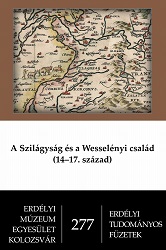A Szilágyság helye a középkori Magyar Királyság
gazdasági életében
Medieval Sălaj (Szilágy) in the Economic Life of the Kingdom of Hungary
Author(s): Boglárka Weisz
Subject(s): Local History / Microhistory
Published by: Erdélyi Múzeum-Egyesület
Summary/Abstract: The medieval territory of Sălaj (Szilágy) region was divided between two counties: Crasna (Kraszna) and Middle Szolnok. The examination of data on the economic administration of the territory can help to better understand the problem of whether these two counties belonged to Transylvania or the Hungarian Plain (Alföld). The primary organization which had no national authority, and held together a welldefined territory especially in matters of taxation, was the chamber. However, not all chambers in the Arpadian age had territorial authority, therefore the territories of the later counties of Middle Szolnok and Crasna belonged to no chamber, while the authority of the chamber of Sătmar county only extended to the customs places on their territories connected to salt transportation or trade. Following the transformation of the chamber system, in the 1320s the chamber of Sătmar had authority over a well delimited territory, extending over the two examined counties. In the 1370s, when the Ispánate of the Chamber’s profit (comitatus lucri camerae) was removed from the authority of the chambers, Middle Szolnok and Crasna fell under the Ispánate of the Chamber’s profit (kamarahaszna, comitatus lucri camerae) of Sătmar. This means that in terms of economic administration the territory of Sălaj belonged not to Transylvania, but to the Hungarian Plain.The region of Sălaj maintained its relations with its close or distant neighbours by way of trade. This was partly achieved through fairs in the territory, and partly by the activity of merchants living there. In the Middle Ages, weekly markets were held in the following settlements in Sălaj region: Cehu Silvaniei (Cseh, Mondays), Agrij (Egregy, Mondays), Ghirișa (Géres, Thursdays), Hodod (Hadad, Tuesdays), Carastelek (Kálóztelek, Thursdays), Camăr (Kémer, Wednesdays), Crasna (Kraszna, Fridays), Coșeiu (Kusaly, Wednesdays), Nușfalău (Nagyfalu, Tuesdays), Sălăjeni (Ököritó, Wednesdays), Șamșud (Sámson, Mondays), Santău (Szántó), Săuca (Sződemeter, Wednesday), Tășnad (Tasnád, Sundays), Someș-Uileac (Újlak, Thursdays), Zalău (Zilah, Saturdays); and annual markets in the settlements of: Cehu (11 June; 18 October), Camăr (Easter), Coșeiu (Ascension Thursday), Nușfalău (1 May; 29 September), Șamșud (12 March; 29 June; 4 October), Santău (16 October), Zalău (13 July). Apparently, the most important fairs which were attended by people from more distant counties as well were held in the village of Nușfalău in Crasna county, where merchants came even from Carei (Károly, Sătmar county) or Debrecen (Bihor county).In addition to trade, the economic importance of Sălaj was also marked by the fact that the salt-route leading to the settlement of Sălacea (Szalacs), a salt deposit already in the Arpadian age, crossed the territory; this route can be reconstructed partly by the salt customs places and partly by road denominations. The route of salt transportation on water led through Sălaj region on the river Someș (Szamos) to Jibou (Zsibó), where the salt was moved on carriages and taken along the Someș to the salt deposit of Sătmar.
Book: A Szilágyság és a Wesselényi család (14–17. század)
- Page Range: 237-254
- Page Count: 18
- Publication Year: 2012
- Language: Hungarian
- Content File-PDF

